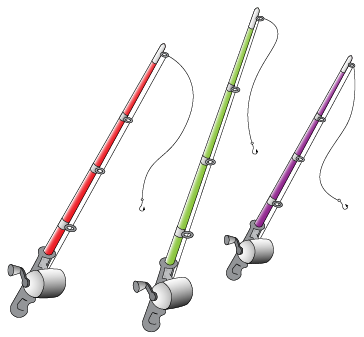E2.2 Explain the relationship between centimetres and metres as units of length, and use benchmarks for these units to estimate lengths.
Activity 1: Inverse Relationship Between the Centimetre and the Metre
Instructions
Teachers draw a two-metre line on the floor or on the board using masking tape. This line can be straight, vertical, horizontal, slanted or zigzagged. This is the tape length. The teacher gives each student either a tape measure in centimetres (Tape A), or a tape measure of one metre (Tape B). They are then asked to measure the tape length and record their measurement in their math journal.
 image A student kneels in front of a line drawn on the floor. He/she measures the line with a tape measure in centimeters, "Tape "A"". A student kneels in front of a line drawn on the floor. He measures this line with an ungraded tape measure. He measures the line with a tape measure in centimeters, "Tape measure "B"".
image A student kneels in front of a line drawn on the floor. He/she measures the line with a tape measure in centimeters, "Tape "A"". A student kneels in front of a line drawn on the floor. He measures this line with an ungraded tape measure. He measures the line with a tape measure in centimeters, "Tape measure "B"".
Students repeat this exercise over five consecutive days. The length of the line differs each day to measure either 3 metres, 4 metres, 5 metres, or 6 metres. At the end of the week, students record the results in a table similar to the one below.
|
Featured Length |
Tape Measure A |
Tape Measure B |
|
Day 1 line |
200 cm |
2 m |
|
Day 2 line |
300 cm | 3 m |
|
Day 3 line |
400 cm | 4 m |
|
Day 4 line |
500 cm | 5 m |
|
Day 5 line |
600 cm | 6 m |
Teachers share and record student observations.
- The 200 centimetre measurement obtained with tape A equals the 2 metre measurement obtained with tape B.
- The 3 metre measurement obtained with tape B equals the 300 centimetre measurement obtained with tape A.
- There are always 100 times more centimetres than metres.
Teachers lead students to make connections between the measurements noted and to make the following conjectures:
- there are several centimetres in a metre (specify that 100 centimetres are equal to 1 metre);
- when the same length is measured in metres and centimetres, the number of centimetres needed to measure the length is greater than the number of metres, since the centimetre is smaller than the metre (inverse relationship).
These conjectures can be verified by other similar situations and one can then formulate the generalization that there are always 100 centimetres in a metre.
Source: translated from Guide d'enseignement efficace des mathématiques de la maternelle à la 3e année, Mesure, p. 64-65
Activity 2: Relationship Between Centimetres and Metres - Fishing Rods
At the Laplante fish farm, Mikael and his family go trout fishing. Mikael chooses a metre long fishing rod, his older brother's rod is 115 cm long and his father's is 1 m and 70 cm long.
Who has the longest fishing rod?

(The length of a metre is equal to 100 centimetres, so Mikael's fishing rod is 100 cm, his brother's is 115 cm and his father's is 170 cm [(1 metre = 100 cm) + 70 cm]. His father's fishing rod is the longest.)
Source: translated from Fiche de la maternelle à la 3e année Attribut longueur, p. 4.
Activity 3: Measuring Length with Standard Units - Benchmarks
Goal
In this activity, students find various objects that are 1 cm or 1 m long.
Material
All kinds of objects whose length or width is about 1 cm and 1 m.
Instructions
Ask students to find a benchmark object that measures one metre and another that measures one centimetre. These objects could be used to determine the length of some other objects.
Examples
- the width of a door frame is about 1 m;
- the width of a Grade 2 student's little finger is about 1 cm.
